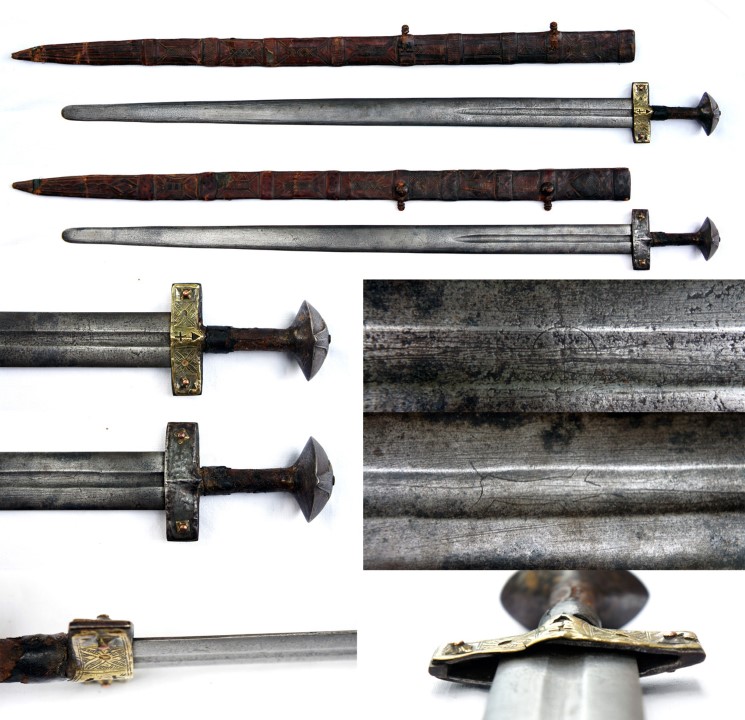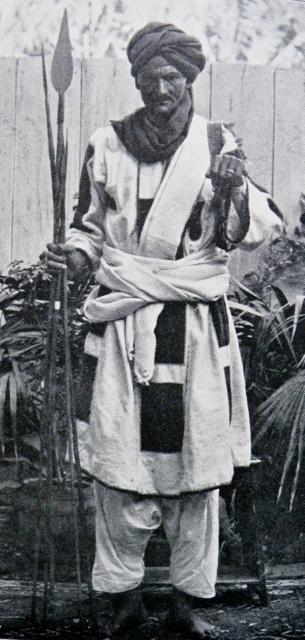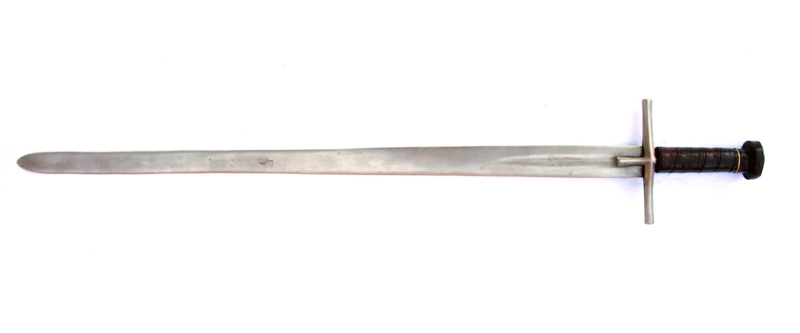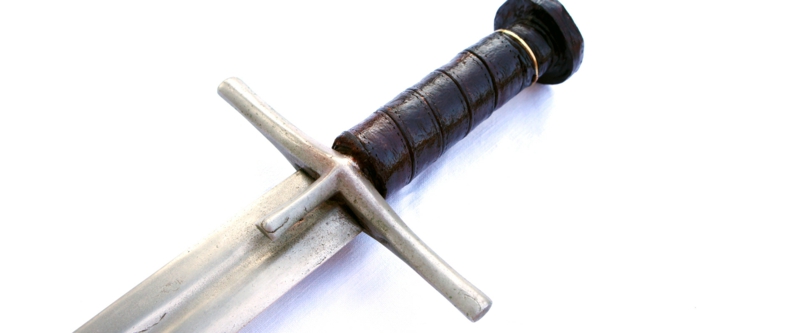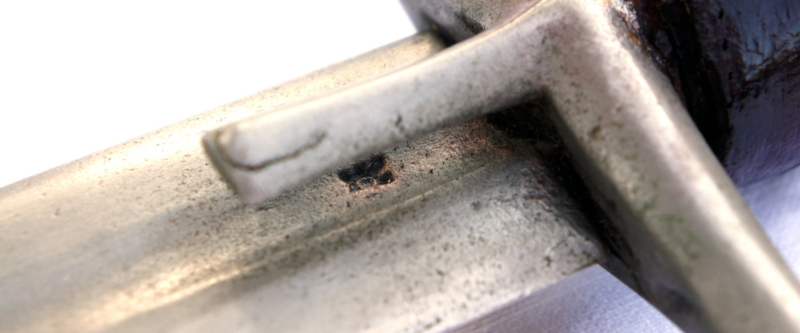Posts: 268 Location: Houston, Texas
Tue 09 Jul, 2013 11:50 am
| Iain Norman wrote: |
As the owner of the takouba.org website I should probably add a few comments (thanks for linking it by the way Jonathan, I'm always happy to see it's useful). :)
Yes, Timo is correct, the influence is more likely to be Arab and Mamluk with respect to hilt of the kaskara. The main source for arms and armour flowing into Sudan was via Egypt. On the takouba side it's a similar story but with different geographical influences. For more on straight bladed Islamic sword this is a nice thread: http://www.myArmoury.com/talk/viewtopic.php?t=17520
Of course from a certain perspective there was European influence, in so much as many of the blades originated there. Both 19th century trade blade and blades from earlier periods as well.
Both kaskara and takouba are still made to this day, mainly as an accessory of traditional dress and for ceremonial use. As Henrik points out, modern steel sources are typically leaf springs from vehicles. The railway steel is also true - the British rail line to Khartoum was completed in 1899.
It's nice to see these under discussion here. Both are rather long lived types and give a fascinating window into African kingdoms such as Sennar, Darfur, the Hausa kingdoms and Bornu.
Here's a nice example held by the British Museum and attributed to a Darfur ruler from the mid 18th century.
http://www.britishmuseum.org/explore/online_t...sword.aspx
I'm also attaching a neat image of a couple of cavalrymen from Kordofan circa 1910. |
Do you know how much these swords weigh and what their center of balance is? I'm curious to know how they handle.
Posts: 75
Tue 09 Jul, 2013 12:38 pm
| Christopher B Lellis wrote: |
Do you know how much these swords weigh and what their center of balance is? I'm curious to know how they handle. |
I can't get you POB figures at the moment as I'm away from the bulk of my collection at the moment. However, to give you a sense of weights, in the attached photo the weights are as follows from the top down:
1. Triple fullered blade and brass hilt - about 720g
2. Triple fullered blade and brass pommel, leather grip and metal guard - about 710g
3. Brass hilt with wide blade - about 785g
4. Brass hilt with brass forte plates and wide blade - about 885g or 890g
So as you can see the weight does vary somewhat significantly. A few others I have might weigh even a bit more.
In terms of how the swords handle... One thing to keep in mind is the intended style of use. Takouba are almost invariably sharpened only for the last 2/3rds of the blade and the style exhibited in surviving sword dances/rituals is extremely tip oriented. Still, I've encountered a range of characteristics with takouba, some are quite tip heavy, others have much more substantial pommels. As a general rule, older swords are much better balanced. However they don't necessarily handle in a similar manner to European weapons - despite some of the visual similarities.
[ Linked Image ]
 Attachment: 69.92 KB
Attachment: 69.92 KB
[ Download ]
Posts: 1,377
Tue 09 Jul, 2013 7:51 pm
Timo and Iain,
Thank you for your replies!
Jonathan
Posts: 1,377
Thu 11 Jul, 2013 8:58 am
Iain,
Thank you for the link. I have an interest in the Niger Sudan Campaign of 1897, a campaign carried out by the Royal Niger Company under the command of young British officers and the Royal Niger Constabulary (mostly Hausas) against Bida, Illorin, and Nupe. I was curious about the types of weapons the Fulani would have used against the small RNC force.
Thanks again!
Jonathan
Posts: 75
Fri 12 Jul, 2013 12:14 pm
| Jonathan Hopkins wrote: |
Iain,
Thank you for the link. I have an interest in the Niger Sudan Campaign of 1897, a campaign carried out by the Royal Niger Company under the command of young British officers and the Royal Niger Constabulary (mostly Hausas) against Bida, Illorin, and Nupe. I was curious about the types of weapons the Fulani would have used against the small RNC force.
Thanks again!
Jonathan |
Hi Jonathan,
In that case, I'd highly recommend "Yoruba Warfare in the Nineteenth Century" by Ajayi J F Ade and Smith Robert. It includes an interesting essay on the Egba army in 1861 by Captain Jones, a British Officer.
All the best,
Iain
Posts: 1,377
Fri 12 Jul, 2013 7:20 pm
Thanks again, Iain! And I was wrong above--I meant to say Egbon, Bida, and Ilorin.
Jonathan
Posts: 200 Location: Hungary
Sun 14 Jul, 2013 11:10 am
A question about the armour of the riders above:
How common was that twisted scarf over the
chainmail??
Posts: 160 Location: Sunshine Coast, Australia
Mon 15 Jul, 2013 4:08 pm
Just interested to know if the Mahdists used two handed swords? Or was this an invention of Victorian painters and illustrators?
Posts: 160 Location: Sunshine Coast, Australia
Tue 16 Jul, 2013 3:52 am
| Iain Norman wrote: |
The answer to this is pretty much two fold. The short version is no - they didn't. The kaskara is a single handed weapon usually used in conjunction with a shield.
The long answer is, sometimes, Baker's "Nile Tributaries Of Abyssinia" from 1861 describes mounted elephant hunters wrapping about 9 inches of the blade in leather cord to allow for two handed use. But this seems to be a rather specialized case. |
Ok, thanks for that. Interesting. To your knowledge, were there any north african cultures that did use two handed swords?
Posts: 160 Location: Sunshine Coast, Australia
Tue 16 Jul, 2013 3:54 am
| Iain Norman wrote: |
The answer to this is pretty much two fold. The short version is no - they didn't. The kaskara is a single handed weapon usually used in conjunction with a shield.
The long answer is, sometimes, Baker's "Nile Tributaries Of Abyssinia" from 1861 describes mounted elephant hunters wrapping about 9 inches of the blade in leather cord to allow for two handed use. But this seems to be a rather specialized case. |
Ok, thanks for that. Interesting. To your knowledge, were there any north african cultures that did use two handed swords?
Posts: 2,307 Location: Croatia
Tue 16 Jul, 2013 5:51 am
| Iain Norman wrote: |
| Christopher Lee wrote: |
Ok, thanks for that. Interesting. To your knowledge, were there any north african cultures that did use two handed swords? |
Off the top of my head, not really, within North Africa you have types like the kaskara, takotakoubayssa, nimcnimcha various styles of saif. However all of these are single handed weapons.
Getting into why there aren't any would be quite the topic! |
Two handed swords are a rather rare occurrence anyway, and they appeared mostly as a weapon of rather heavily armored troops, so no wonder Africa has none...
Posts: 200 Location: Hungary
Tue 16 Jul, 2013 11:11 pm
Thank you for the quick answer, Mr. Norman!
Posts: 268 Location: Houston, Texas
Sat 27 Jul, 2013 4:28 pm
| Iain Norman wrote: |
| Henrik Zoltan Toth wrote: | | Thank you for the quick answer, Mr. Norman! |
No problem! I thought it might be interesting for this thread to show a recent kaskara of mine. Latten inlaid running wolf and the "fly" mark stamped underneath each langet. |
I like that sword, it reminds me of my Albion steward. It's like a homemade version of it, in looks anyway. Handling I have no idea, it's probably quite different.
Posts: 75
Sun 28 Jul, 2013 12:08 am
| Christopher B Lellis wrote: |
I like that sword, it reminds me of my Albion steward. It's like a homemade version of it, in looks anyway. Handling I have no idea, it's probably quite different. |
Thanks Christopher, the Steward of course is a geometry from an earlier period but yes there is some similarity. This particular blade was almost certainly made in Solingen.
In terms of handling, with all kaskara the lack of a substantial pommel means they tend to be somewhat blade heavy. Still, this is a light sword and the blade is agile.
You
cannot post new topics in this forum
You
cannot reply to topics in this forum
You
cannot edit your posts in this forum
You
cannot delete your posts in this forum
You
cannot vote in polls in this forum
You
cannot attach files in this forum
You
can download files in this forum
